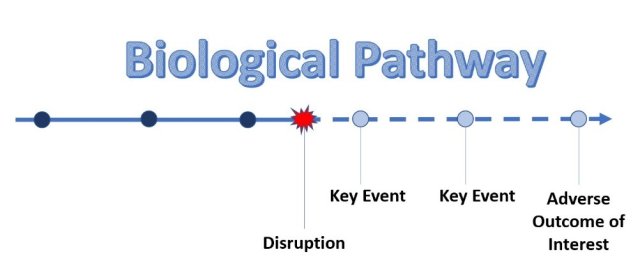From Exposure to Impact: Developing Adverse Outcome Pathways to Support Chemical Risk Assessment
Published August 2, 2023

Chemical exposure can impact human, animal, and ecological health. EPA researchers are working to increase and document our understanding of chemical effects on biological systems. One specific area of research investigates how a chemical exposure can trigger a series of events that lead to an adverse environmental or human health outcome. This research area is referred to as Adverse Outcome Pathways (AOPs).
Background
An AOP describes a series of linked events at different levels of biological organization (like a cell, tissue, or organ) that lead to an adverse health effect in an organism following exposure to a stressor. EPA researchers develop AOPs for adverse environmental or human health outcomes that are relevant to risk assessment or regulatory decision making.
AOPs can be thought of like a series of dominos. The first “domino” is a chemical exposure that leads to a biological change within a cell (like a chemical binding to DNA). That change then triggers more dominos to fall in a cascade of sequential “key events” (such as abnormal cell replication) along a toxicity pathway. Together, these events can result in an adverse health outcome (like cancerous cell growth) on a whole organism.

AOPs help scientists identify which chemicals may be hazardous based on what is known about their biological effects. AOP networks, meaning two or more related AOPs, can be assembled by linking individual AOPs by shared key events. The assembly of these networks provide insight into the complex interactions among biological pathways.
Because key events are measurable, researchers can use AOPs to predict the magnitude of a biological change that would need to occur before an adverse health outcome is observed. This information can help risk assessors determine how much exposure to a chemical (or chemical mixture) may lead to adverse health outcomes in a population.
AOP-Wiki: A Crowd-Sourced AOP Repository
There are many researchers worldwide studying responses of organisms to stressors, which can lead to fragmented and widely dispersed scientific knowledge. AOPs are intended to integrate and synthesize that information in a systematic, public, searchable, and, to the extent possible, both human and machine-readable format.
Originally launched in 2013, the AOP-Wiki (Wiki) is a globally accessible platform for developing and disseminating AOP descriptions in accordance with international guidance and templates. The Wiki serves as the official and primary tool for entering new AOP information and accessing previously assembled AOP information. The Wiki can be searched by biological effects to find test methods or measurements linking back to a stressor, such as a certain chemical exposure. The AOP-Wiki, currently at version 2.6, features:
- The virtual AOP Developers’ Handbook (A “how-to” guide for development/description of AOPs in the AOP-Wiki)
- AOP development coaches (Experienced developers that can answer questions and ensure compliance with international guidance)
- Training and introductory resources
- Access to the AOP Forum
- Peer-review from approved AOP reviewers and experienced AOP developers
- Continuously improved searching and filtering capabilities
- FAIR principles (Data is Findable, Accessible, Inter-operable, and Re-usable)
From 2013 to 2023, the AOP-Wiki has gone through ten years of continuous development. The Wiki was, and continues to be, a crowd-sourced and open-access effort that focuses on sharing information and avoiding redundant research efforts. To date, AOP-Wiki development has been most strongly influenced by AOP developers and needs of the AOP program, guided by the Organisation for Economic Co-operation and Development (OECD).
